Music In The Mountains
The 2017 Edition of the Rocky Mountain Audio Fest
In year’s past, the Rocky Mountain Audio Fest (RMAF) has been hampered by an aging, rather stale venue, and backward looking management. This year, things were looking up with the hosting hotel being newly refreshed and the exhibitors better able to cope with the remodeled rooms.
Rather than driving to the show to combine work with a bit of a holiday, this year I flew in, grabbed a subcompact, and drove the better part of an hour to my hotel near the show. Friday morning, I was up bright and early for the press–only preview, leading off the general admission hours to follow.
I’m one of those guys who’s been wearing headphones since I was introduced to higher fi’, so I love what has recently happened to cans. Since my last foray into headphones here in HifiZine two years ago, performance has jumped up several notches. At the show, the newly relaunched Acoustic Research were debuting several new products, including a new over–the–ear open back, the AR-H1.
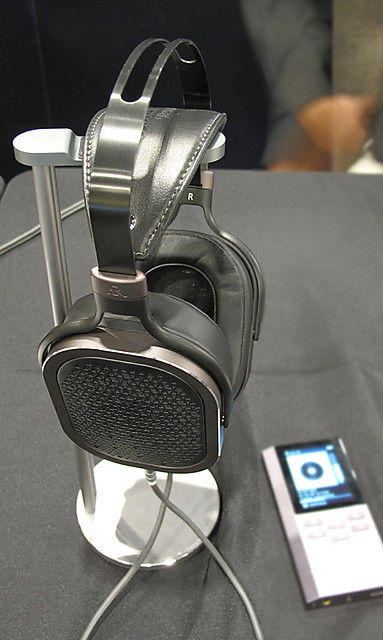
Acoustic Research’s new AR-H1 planar magnetic
The speeds & feeds tell part of the story: 86 mm driver with a neodymium magnet array, frequency response of roughly 10 Hz to 70 kHz, and nominal impedance of 33 Ω. Being circumaural, fairly lightweight and having a low clamping force, comfort should be quite dialed though I didn’t wear them for more than a minute. The AR-H1 comes with a 1.2 m audio cable (3.5 mm 3-pole to dual 2.5 mm 2-pole), a 6.3 mm plug adapter, and a soft pouch. At a suggested retail price of $599, and a clean, dare I say open, sound, these good looking guys deserve a listen.
Wireless cans continue their advance. At some point in the future, most all head/earphones will be wireless, with only the bottom feeder bargain models and specialist audiophile models retaining cords. This was the first show I heard about aptX HD, an updated version of Qualcomm’s now classic lossy codec. aptX HD supports up to 24/48k, as compared to plain Jane aptX with 16 bit/44.1 support. With the HD version, compression is still 4:1, with a bit rate of 576 kbps – up from 352 kbps in the previous iteration – to accommodate the larger payload. So, even with the HD flavor, high rate HRA audio needs to be sample rate down–converted to 48 k, and the resulting data is then compressed at about the same ratio as DTS.
The result? While not truly high definition, the subjective quality is quite good, with only the most discerning listener finding anything to object to. For those of us who notice a difference between a 176.4 master file and a down–rez’d 44.1 child version, the sample rate conversion will also damage the sound a good bit. For some, convenience is king but, for me, wired cans will continue to be my choice as I’d rather put up with the small hassle of cables rather than degrade my music.
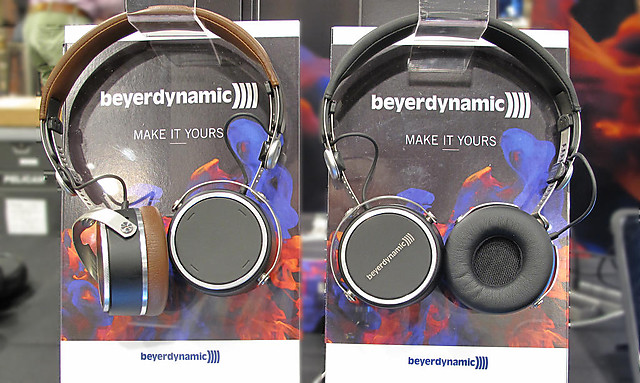
Beyerdynamic’s Aventho wireless headset uses Bluetooth 4.2 with aptX HD
Last year, DAPs took a turn, either for the better or worse, depending on who you talk to… DAPs or Digital Audio Players (somebody please find a better TLA for this product class!) are those portable self–contained HRA players that started with 2013’s AK100 from Astell&Kern*. Last year, low cost versions started to appear from unapologetic Chinese brands. Granted, many of the DAPs out there are largely manufactured in mailand China, but at least there’s one or more product managers guiding the development and voicing. I have yet to hear a model from Lotoo, Cayin or others that kicks my fidelity–first butt but, in time, steady improvements should carry these entry level products to some sort of higher fidelity.
At Rocky Mountain, I got to listen to Shanling’s latest passel of pocketable players. The tiny, $150 M1 (60 x 50 mm) has bi–directional Bluetooth with aptX, and supports up to DSD2 via transcoding. Maximum sample rate is 192k. Next in line is their M2s, which is about phone–sized and retails for about the same price. Capabilities are also about the same, so that model is aimed at folks who’d like an easier-to-read display and easier-to-locate size.
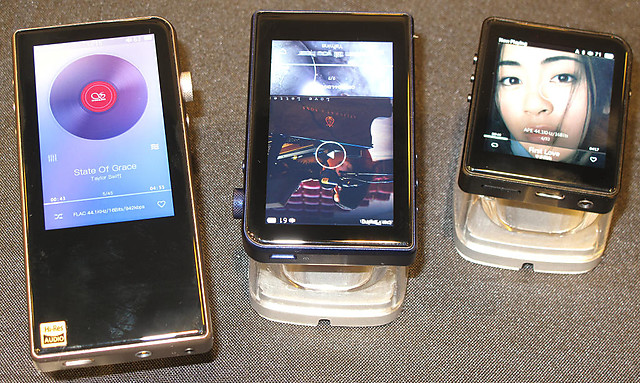
From left to right, Shanling’s M3s, M2s and M1 DAP
The M3s jumps up the quality a bit, with native DSD4 and DXD support and balanced out on a 2.5 mm connector. Sound quality–wise, the M3s is on par with my ancient AK120, which isn’t saying much these days. Still, it retails for about $360. That’s a relative bargain though the same price as the Ponoplayer which still bests it in quality – specifically soundstaging, low amplitude detail and timbral neutrality. In 2018, I’ll be putting together a survey and reviews of a select group of DAPs and, though unlikely, I may be able to get Shanling’s top of the line M5 to compare to players from more established brands.
Another DAP at the show, from Korean manufacturer The BIT Co., was the Opus #1. Nice build quality, though unfortunately I didn’t get to do any listening. Also, I tried to contact The BIT Co. with two different e–mail addresses, and received a reply from neither.
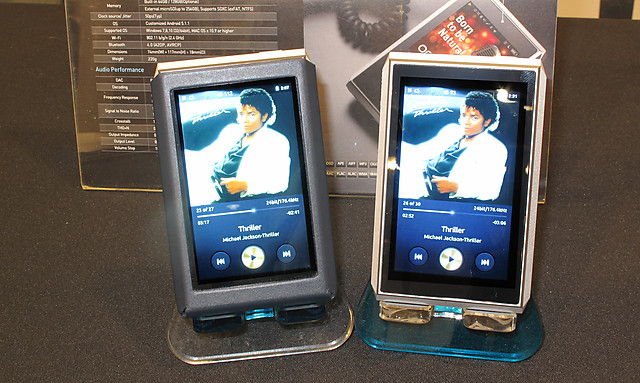
The BIT’s Opus #1 DAP
On to other rooms… Adam at Madisound set up a really fun and unusual demo room. His aim was to teach a bit about physics and electronics, and that he did!
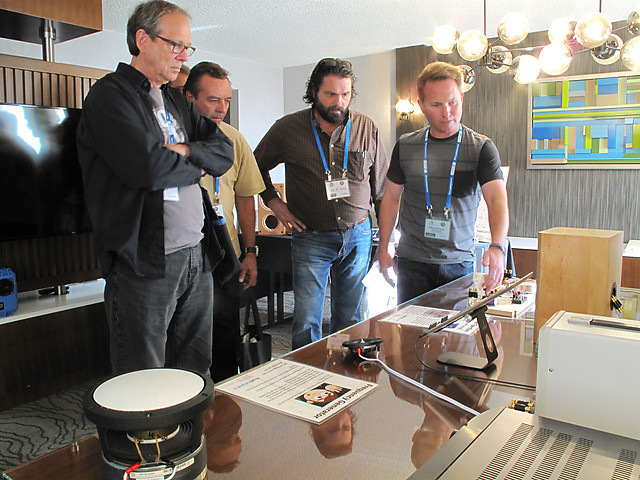
Adam, far right, demming a basic crossover
He had a naked voice coil and former, along with a matching magnet assembly from a loudspeaker, to show how electrodynamic loudspeakers work. Drop the voice coil into the gap, apply voltage from a battery to the voice coil and, vroom, the voice coil jumps up and out of the gap! Yes Elizabeth, electromagnets do work! Another show & tell he had (or was it show & hear?) were the basic elements of a crossover. Employing plywood, some knife switches, a capacitor and an inductor, he used series capacitance to create a high pass, and series inductance to provide a low pass. His values were chosen so as to clearly hear the effects of each. Most excellent.
Michal & Chabon at Mytek had a prototype of the next generation Manhattan on demo, featuring MQA decoding. Very kewl but a bit abstract. Far more concrete, and in keeping with the general hipster vibe at the show was their vinyl–centric “living room” setup down in the lobby, designed to provide a good sounding chill spot with stylish, compact and affordable gear.
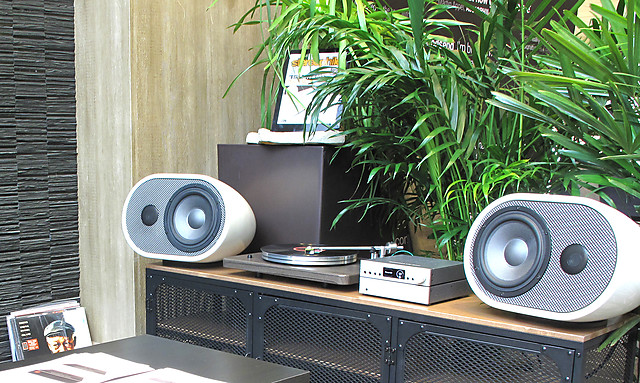
Mytek’s amp & DAC playing to the couch
The entire setup was composed of a turntable, passive speakers, a Brooklyn DAC and their newish matching Brooklyn amplifier. The DAC has a very good sounding phono pre and the amp delivers up to 400 Watts into 2 Ω loads. A bundle of the amp and DAC goes for $3395, and most folks don’t need more cost or complication than that. The dynamic Brooklyn duo pretty much takes care of everything the average listener could ask for.
As is always the case at RMAF, I spent quite some time with Michal, discussing pro audio, the state of CE (Consumer Electronics, of which high end audio is a minuscule segment), and new developments in the world of audio tech. Mytek has been working on their latest product, Clef, a portable DAC. Clef fully supports MQA, and easily fits in your pocket. They had serious issues with their casework supplier but Mytek have now announced that Clef is shipping.
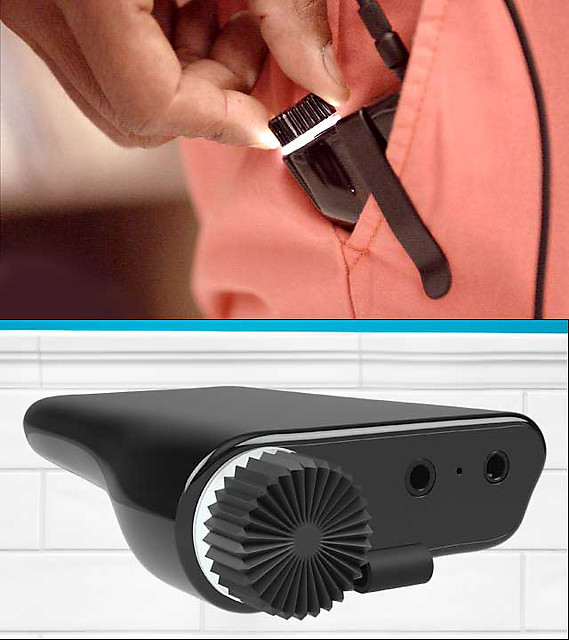
Clef, the best sounding way to bring MQA with you…
That’s all I’ve got on this year’s show. It was a vast improvement over last year, with better logistics, better amenities, and most importantly, better sound overall. That said, the difficult room acoustics at the chosen venue will continue to be a problem. In another couple of months, AXPONA will be in full swing at a new venue. It’ll be interesting to hear how the new rooms sound.
For more on the 2017 RMAF show, download my report for audioXpress magazine. Until next time, thanks for listening!
* — Neither an astel nor kerning has anything whatsoever to do with music but, Korean parent company iRiver probably thought Astell&Kern sounded solidly Euro.



